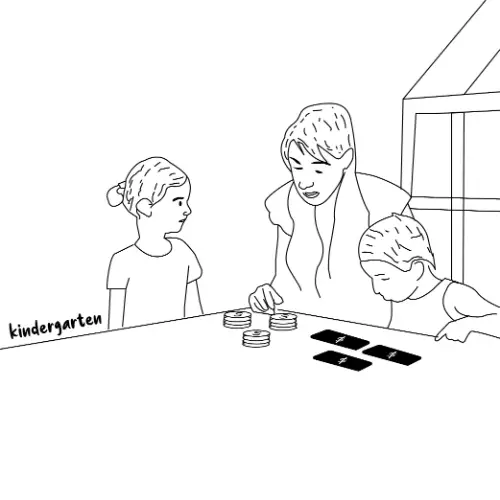To a kindergartener, the world is a fascinating and limitless place, full of learning opportunities. One of those opportunities is financial education: teaching these kids about money is vital, and they can build an incredible foundation if they understand essential concepts. According to the Fifty Nifty Econ Card program offered through the Federal Reserve Bank of Kansas City, kindergarteners should understand a specific set of ideas by the end of the year. These topics include wants, needs, scarcity, choice, goods, and services. They should also understand denominations of money and have a general idea of the different values of currency that we use in the United States. Knowing what to teach in each grade is imperative, and by sticking to the topics laid out in this guide, you can be confident in the instruction of your kindergarten learners!
National Standards for Personal Finance Education
Download Our Free Teachers' Cheat Sheet
Our free cheat sheet covers every learning objective in the National Standards for Personal Finance Education and the corresponding Kids' Money Lesson Plans - we cover each and every standard!
Wants
Wants are items people like and desire, and kindergarteners have an innate understanding of this idea (candy, anyone?). However, teachers can start to go over the concept of wants related to money education, giving students the idea that the things they want are not free, but cost varying amounts of money. You can explain how people of all ages have wants, where people go to buy the things they desire, and what kinds of goods and services are out there to purchase.
Teaching wants is a critical concept for kids to learn, as they can connect their present understanding of desiring something to eventually buying it. You can reinforce the topic of wants by having your students:
- Make a list of their wants. You can guide them to prioritize their items in order of importance, explaining that they will have to choose between things they want to buy as they get older.
- You could further their understanding by showing them how adults wish for fancy cars, big houses, and the latest electronics, but also that many people cannot afford to spend that much money. Students will begin to see that you can’t just buy anything you want, and many factors influence how many wants you can buy in the future.
Kindergarten Lesson Plan #1
Wants
Want to Get All Kindergarten Lesson Plans?
Needs
As students understand what wants are, you can also introduce the notion of needs to them. Much different than things you desire, needs are requirements to live. Food, shelter, and clothing are some needs, and there are many other necessities as we get older. Teachers can emphasize how money plays a central role in meeting people’s needs, showing students specific costs that adults must pay every month, week, and day to survive. While not as “fun” for kindergarteners as getting into all the things they want, this topic is critical to their future.
Educators can approach the topic of needs in multiple ways. Some of these methods include:
- Create a Venn Diagram showing wants vs. needs. By listing out their personal items, students understand the difference between these two crucial categories. They can draw pictures of the various needs right now and those they may have as they grow up.
- Students can conduct basic research on how much needs may cost. They can look at the prices of items they would find in a grocery store, deciding what kinds of things they would buy as needs and what they would purchase as wants.
Kindergarten Lesson Plan #2
Needs
Scarcity
As one of the foundations of economics, the concept of scarcity is essential to start teaching early on to your students. Scarcity is when there are not enough products, goods, or services to go around, which affects the cost and availability of specific things. You can explain that this idea impacts all areas of life, from food to technology to basic needs. Scarcity can impact land, water, housing, healthcare, and more, and showing your kindergartners that resources do run out or dwindle is crucial.
Getting your students to understand scarcity is straightforward but becomes complex quickly when linking it to financial resources and money management. For these little ones, the most important thing to show them is how everything is limited. Some ways to demonstrate this include:
- Create an activity that displays many objects in separate categories: chocolate bars, books, toys, and others. Give kids a time limit and let them choose a specific number of items as possible (watch how fast the chocolate goes!). They will begin to see that scarcity will affect everyone, whether in their primary “wants” or things that they may not prioritize. Students will have several items in front of them and need to consider if they chose wisely, were emotionally affected by the process, and how they chose the objects they did.
Kindergarten Lesson Plan #3
Scarcity
Choice
Choice is the act of making a decision. As kindergarteners gain more independence, they become more assertive in decision-making and make their own choices: favorite colors, which activities they want to participate in, and deciding between clothes and foods. You can connect this skill with money education by explaining that adults choose how they manage money all the time. You can save, spend, earn extra, or invest cash however you want, and kids benefit by learning this idea early on.
Educating kindergarteners about their choices and the results of those decisions will serve them well in their futures. There are several ways to teach little ones about this concept, such as:
- Give students a set number of bills to spend. Tell them they can choose to buy a number of items from the student store or save money for a bigger reward next time. After they come up with an assortment of items they purchased, teachers can explain that this is how having money works: you can spend it all at once, you can buy a few things with your earnings, or you can save the bulk of it for a more substantial purchase or just to build your wealth. The choice is theirs!
Kindergarten Lesson Plan #4
Choice
Goods
Teachers can explain the concept of goods - things people can buy to satisfy their wants and needs. You should cover what goods are, pointing out their school supplies, clothing, shoes, and items around the school. You can teach them that the world revolves around buying and selling goods, letting us gain possessions that we want and need, helping individuals make money, and different goods have different prices. They should understand that we use the money to purchase goods and that there are multiple ways to pay for items we want.
You can give learners an excellent overview of goods with many activities available today. Teachers can:
- Show students that there are goods everywhere you look. Have them match pictures of goods into charts showing goods versus services so they begin to see the difference between items you can pick up at the store and other types of products. Teachers can explain the importance of goods, why people choose various items to spend their money on, and how individuals have unique demands that influence which products they buy.
Kindergarten Lesson Plan #5
Goods
Services
Similar to goods, services are things that we buy, but usually in the form of an activity. Internet, cable, streaming apps, and meal delivery programs are just a few examples of services. You can tell kids in kindergarten that services are everywhere, including online, at home, at school, and all around town. That show or nursery rhyme they watched on the Internet was likely part of a service, as are Mommy and Daddy’s cell phone plans. In this grade, you can introduce both goods and services as significant factors of economics, so children can begin to see how these things are interconnected.
You can illustrate the idea of services in many ways, making it engaging for little learners. Educators can help students get the concept by:
- Explain the difference between goods and services, having the students separate images into piles. Create a Kahoot or online quiz game showing goods vs. services, crowning a winner, and celebrating the participation of all your little scholars.
Kindergarten Lesson Plan #6
Services
Money Denominations
One main focus of the money education curriculum in kindergarten is for your students to understand different denominations of money. By the end of the school year, the hope is that all kids can identify coins and bills of various amounts and count to specific numbers with the currency.
There are lots of activities that help kids comprehend money. These methods include:
- Have students identify the different symbols on coins and paper bills.
- Kids verbally explain various currencies and their worth.
- Come up with multiple combinations of coins and bills to reach the exact total, showing students that you can get to the same number in different ways.
- Have learners “buy” an item from the classroom store and understand how much value that item was worth by comparing how much money they had to begin with and how much they have left over.


